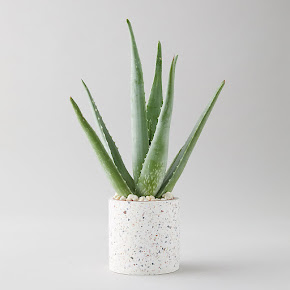There are a lot of plants commonly sold as houseplants that
can be dangerous for people and pets; the list is surprisingly long. With these
types of plants, there are more inherent dangers for pets (cats and dogs) but small
children who chew on everything can be at risk as well, so keep an extra-close
eye on those kiddos around them. In this list, I am concentrating on plants
that may actually pose a threat to adult humans who live around them. It pays
to educate yourself because in many cases the plant seller either downplays the
risk or does not acknowledge it at all.
Sago Palm (Cycas revoluta) –
First of all, these are not palm trees - they are Cycads, an ancient type of plant that dates back
to prehistoric times. These are incredibly tough, slow-growing plants that are
clearly on this planet for the long-haul. Perhaps part of their successful longevity
can be attributed to their toxicity. Sago Palms contain cycasin, a neurotoxin that causes a litany of unpleasant
symptoms and then liver damage, liver failure and death. All parts are poisonous,
but the danger is concentrated in the seeds. The good news is that the plant
parts have to be ingested for the poison to take effect and most animals avoid
this plant. It is the unwitting or unwise human who may purposely ingest this
that are at serious risk. Perhaps it’s best to choose another plant for your
house – they take too long to grow anyway.
Euphorbia spp –
All of the succulents in this family are toxic, with some
being no-so-much and others being highly toxic. In all likelihood, you will not
be informed by sellers as to which ones are worse when you are out shopping so you
may as well consider all of them highly toxic. To be on the safe side, as the saying
goes. The danger here, and it’s quite serious, is that these plants have a
milky sap that is super-toxic. These plants also poisonous if ingested, but ingestion
is not likely to happen in the normal course of events.
What does happen is that people take cuttings
or do trimming-up and repotting and come in contact with the sap. It is
extremely irritating to the skin and mucus membranes (keep your hands out of
your mouth!), but the effects can be tragic if it is gets in your eyes.
This article has
more to say on this. These plants have become very popular, with the
Pencil Cactus (
Euphorbia
tirucalli) being one of the most popular.
With the real danger literally in these
plants, it may just be best to plant them outside. When planted outside, succulents
in general may even help keep your house safe from fires by serving as a
firebreak.
Peace Lily (Spathiphyllum)
–
These pretty plants have become known among plant collectors
for their air purifying qualities. And while that may be true, they also
contain calcium oxalate crystals in their sap that are like tiny little needles.
As with the Eurphorbia, this liquid can come into contact with skin (and eyes,
and mouth) with general plant care. This contact may not be dangerous (again,
unless it gets in your eye), but it can be extremely unpleasant. Should a
person ingest the flowers or seeds, however, it can cause diarrhea and vomiting
and other increasingly disagreeable symptoms; some patients even end up
hospitalized.
According to this article,
it actually
makes the blood toxic.
Because the crystals make eating this plant
painful and swallowing difficult, severe poisonings are rare and usually of an
accidental nature.
Aloe Vera (Aloe barbadensis miller) –
Yes, that Aloe Vera that seems to be in everything from body
lotions to makeup to health drinks. The thing is, while the gelatinous inside
of the leaves is an excellent topical ointment that soothes and helps heal any
number of skin conditions, the outside of the leaves are not so good. Strangely
enough, that part of the plant
can cause serious skin irritation. And, like everything else on this list, it should not
be ingested. Although it is commonly used as a laxative, latex produced from
the aloe
should definitely not be taken orally.
Scientists have discovered that this
plant causes cancer in animals and, by extension, most likely people. Which
means, of course, ingesting it for health benefits may have the exact opposite effect
that’s desired. Just stick to rubbing the gel on your skin and you’ll be fine.
These are the plants that you could easily come into contact
with that could easy hurt you. Please bear in mind that there are many plants I
left off this list that can seriously sicken or kill your pets, so please do
your homework before you bring something home. The ASPCA (American Society for
the Prevention of Cruelty to Animals
®) has a site with a comprehensive list
of plants that are toxic to dogs, cats and horses. Check it out
here before you adopt anymore plants.
On another note, if you are interested in scary-potent
plants check out this article on the world’s deadliest flowers.
Submitted by Pam











No comments:
Post a Comment